
Learn Bridge Very Slowly
Apprenez Le Bridge Pas a Pas
Apprenez Le Bridge Pas a Pas



Jacques Lumbroso
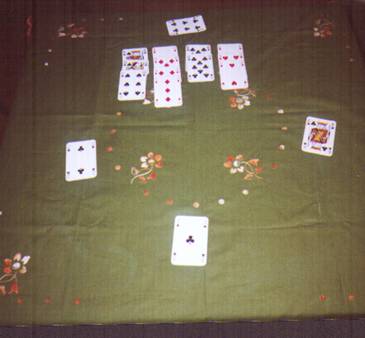

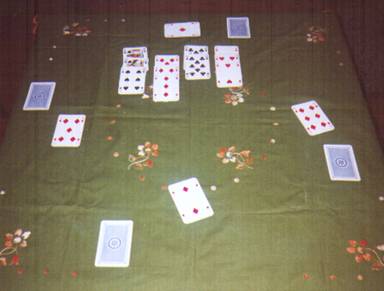
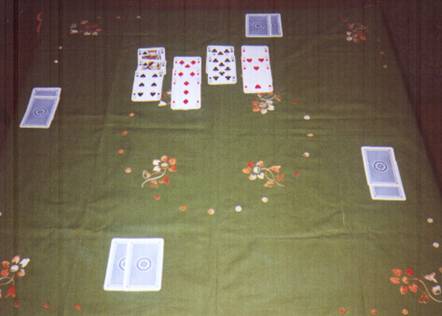
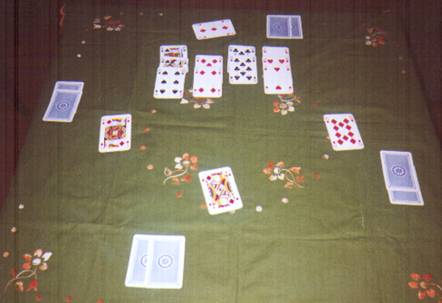
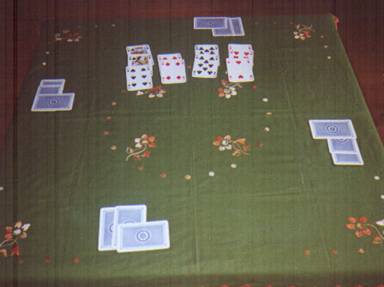
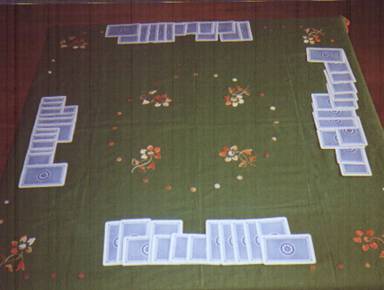
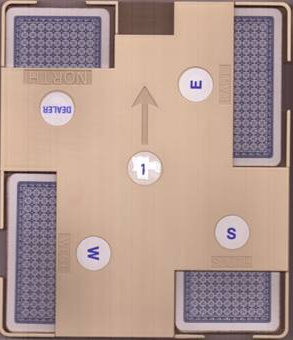

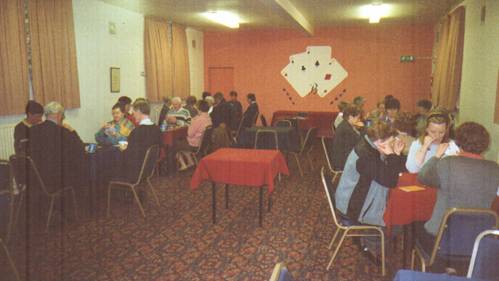
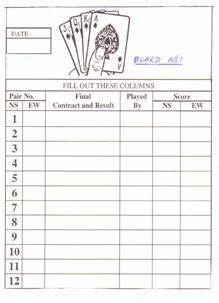
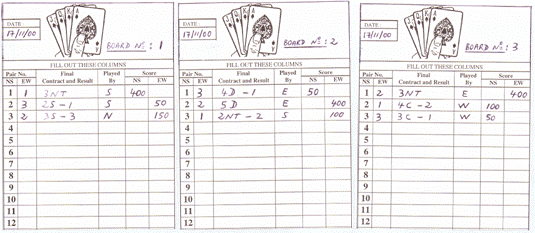
4) THE TWO MAIN REASONS FOR THE POPULARITY OF THE GAME
A long time ago, two Americans, Mitchell and Howell, invented a few ways of having the same hands played by different people, so as to actually compare the players on their abilities, not on their luck. Experts will often make more tricks than other players, in this way getting better scores.
The basic idea is to allow the players to keep their cards after having played them.
Instead of playing the cards in the middle of the table, each player plays his own cards in front of himself, near the edge of the table. For example we will take the exact same set-up as paragraph F, and then the four cards of the first trick should be played like this:
A long time ago, two Americans, Mitchell and Howell, invented a few ways of having the same hands played by different people, so as to actually compare the players on their abilities, not on their luck. Experts will often make more tricks than other players, in this way getting better scores.
The basic idea is to allow the players to keep their cards after having played them.
Instead of playing the cards in the middle of the table, each player plays his own cards in front of himself, near the edge of the table. For example we will take the exact same set-up as paragraph F, and then the four cards of the first trick should be played like this:
Then, instead of the winner of the trick keeping the bundle of four cards in front of him, each player keeps his card near the edge of the table and, when the four cards are played, faces it down:
.pointing lengthwise towards partner if winning.
.pointing sideways if losing.
In our example it would look like this:
.pointing lengthwise towards partner if winning.
.pointing sideways if losing.
In our example it would look like this:
Clearly showing that North-South won the trick(cards pointing towards partner), and that East-West lost it(cards pointing sideways).
The same four cards as before would be played for the second trick, but of course in the new way:
The same four cards as before would be played for the second trick, but of course in the new way:
So the second trick is also for North-South:
The same four cards as before would be played for the third trick, also in the new way:
Now East-West are the winners of the trick, and turn their cards down to show it(pointing towards each other), while North and South turn theirs down pointing sideways:
The play continues as before, and in the end North-South make eight tricks and East-West five tricks, but this time it looks like this:
It is now possible for each player to pick up his thirteen cards again, and perhaps have a friendly “post-mortem” with his partner, discuss how the two hands could have been bid or played better, or simply congratulate each other on a good result!
Also, and even more importantly, each player can now gather his thirteen cards in a little bundle, and put them, face down, in the pockets of what is called a “board”. The North player puts his cards in the North pocket. The East player puts his cards in the East pocket, etc… In this way it is possible for the board to be sent to another table, where four new players can play the very same cards(without shuffling them of course), and results can be compared later on.
Also, and even more importantly, each player can now gather his thirteen cards in a little bundle, and put them, face down, in the pockets of what is called a “board”. The North player puts his cards in the North pocket. The East player puts his cards in the East pocket, etc… In this way it is possible for the board to be sent to another table, where four new players can play the very same cards(without shuffling them of course), and results can be compared later on.
This is what a board looks like:
Each pocket has a little tag: "S" for South, "W" for West, etc…
The number of the board is written in the centre(here number 1).
The Dealer is always clearly indicated. For board number 1 it is North. The "Dealer" sign appears to be written upside down, but it looks normal if you sit in North s seat, on the other side of the table!
Of course the cards are not re-dealt when they reach another table, and the designation of Dealer is only there to indicate which of the four players is the first to bid or pass.
Dealer can be any player. For example it can be East in board 14:
The number of the board is written in the centre(here number 1).
The Dealer is always clearly indicated. For board number 1 it is North. The "Dealer" sign appears to be written upside down, but it looks normal if you sit in North s seat, on the other side of the table!
Of course the cards are not re-dealt when they reach another table, and the designation of Dealer is only there to indicate which of the four players is the first to bid or pass.
Dealer can be any player. For example it can be East in board 14:
After it has been played at a second table, the board can be moved to a third table, to be played by four new players, and so on to as many tables as there are in the room.
A lot of people usually gather once a week in a "bridge club", to play for a few hours:
A lot of people usually gather once a week in a "bridge club", to play for a few hours:
If, for example, there are eight tables of four people, a board can be played up to eight times, and the results compared, thanks to a "score sheet", that the players fill up after each game. This score sheet is found in a little pocket on the side of the board, and looks like this before play begins:
Another very interesting point is that, as well as the boards moving from table to table, some pairs also move from table to table, in order to play against different pairs. It is called a "tournament".
A very simple tournament was designed by Mr. Mitchell a long time ago, for twelve players. The six pairs sit around three tables, called table 1, table 2 and table 3. At table 1, the North-South pair is given a number: 1 North-South(written 1NS), and the East-West pair is given the number 1 East-West(written 1EW). Similarly at table 2 we have pairs 2NS and 2EW, and at table 3 the pairs 3NS and 3EW.
Immediately after sitting down, one board is given to each table: board 1 to table 1, board 2 to table 2, and board 3 to table 3. The cards are shuffled, dealt, bid and played, and scores entered in each of the three score sheets. Once that first "round" is over, the North-South pairs are told to remain seated, and the East-West pairs asked to move to a different table: 1EW to table 2, 2EW to table 3, and 3EW to table 1. The boards are moved at the same time: board 3 to table 2, board 2 to table 1, and board 1 to table 3. Players are now told neither to shuffle nor to deal the cards, but to take them out of their pockets, bid and play them, and then enter their scores on the sheets.
Once that second round of play is over, the North-South pairs are told to remain seated, and the East-West pairs are told to move again: 1EW to table 3, 2EW to table 1, and 3EW to table 2. At the same time, the boards are moved again: board 3 to table 1, board 2 to table 3, and board 1 to table 2. Of course the players do not shuffle and deal the cards, just bid, play and enter the scores on the sheets. The third and last round is over.
If you study the above carefully, you will notice that each pair has played the three boards, against three different pairs. No pair has played the same board twice, nor met the same opponents twice. The scores on the three sheets can now be compared, and a clear winning pair is quickly found.
The same type of tournament could be played with more than one board per table at each round, to make it last longer, and also with more than three tables (in fact any number of tables), to suit the number of people arriving in the club on the day.
That is definitely the first of the two main reasons why bridge has become so popular. Suddenly two people can have a lot of harmless fun for a few hours, while at the same time getting to meet new people, round after round. A lot of people have made new friends in bridge clubs. It is also very common for bridge clubs to welcome lone players, coming without a partner, and providing them with partners on the day. Loneliness at home is then quickly forgotten.
The second reason, as mentioned before, is that players are compared on their abilities, not on their luck.
Let’s see an example of what could have happened in the tournament for twelve players described above:
A very simple tournament was designed by Mr. Mitchell a long time ago, for twelve players. The six pairs sit around three tables, called table 1, table 2 and table 3. At table 1, the North-South pair is given a number: 1 North-South(written 1NS), and the East-West pair is given the number 1 East-West(written 1EW). Similarly at table 2 we have pairs 2NS and 2EW, and at table 3 the pairs 3NS and 3EW.
Immediately after sitting down, one board is given to each table: board 1 to table 1, board 2 to table 2, and board 3 to table 3. The cards are shuffled, dealt, bid and played, and scores entered in each of the three score sheets. Once that first "round" is over, the North-South pairs are told to remain seated, and the East-West pairs asked to move to a different table: 1EW to table 2, 2EW to table 3, and 3EW to table 1. The boards are moved at the same time: board 3 to table 2, board 2 to table 1, and board 1 to table 3. Players are now told neither to shuffle nor to deal the cards, but to take them out of their pockets, bid and play them, and then enter their scores on the sheets.
Once that second round of play is over, the North-South pairs are told to remain seated, and the East-West pairs are told to move again: 1EW to table 3, 2EW to table 1, and 3EW to table 2. At the same time, the boards are moved again: board 3 to table 1, board 2 to table 3, and board 1 to table 2. Of course the players do not shuffle and deal the cards, just bid, play and enter the scores on the sheets. The third and last round is over.
If you study the above carefully, you will notice that each pair has played the three boards, against three different pairs. No pair has played the same board twice, nor met the same opponents twice. The scores on the three sheets can now be compared, and a clear winning pair is quickly found.
The same type of tournament could be played with more than one board per table at each round, to make it last longer, and also with more than three tables (in fact any number of tables), to suit the number of people arriving in the club on the day.
That is definitely the first of the two main reasons why bridge has become so popular. Suddenly two people can have a lot of harmless fun for a few hours, while at the same time getting to meet new people, round after round. A lot of people have made new friends in bridge clubs. It is also very common for bridge clubs to welcome lone players, coming without a partner, and providing them with partners on the day. Loneliness at home is then quickly forgotten.
The second reason, as mentioned before, is that players are compared on their abilities, not on their luck.
Let’s see an example of what could have happened in the tournament for twelve players described above:
It appears that pair 2EW has done very well, scoring a total of 950 points for the three boards, by far the best of the six pairs(150 points with board 1, 400 points with board 2, and 400 points with board 3). They played the same cards as the other EW pairs, so it can be said that their skill paid off, rather than their luck. So, at the end, it is announced that pair 2EW is the winner of the tournament.
Just a few remarks on the three score sheets above:
-“played by” indicates which player was Declarer.
-if “-1” follows a contract, it means that there was one undertrick.
-if “-2” follows a contract, it means that there were two undertricks, etc…
-if no result follows a contract, it means that the contract was “just made”(the number of tricks bid were exactly made).
-if “+1” follows a contract, it means that there was one overtrick, etc…
At this stage, it may be a little too soon for you to enjoy and do well in a tournament in a Bridge Club. My advice to you is to keep playing at home with your friends and to read on.
Just a few remarks on the three score sheets above:
-“played by” indicates which player was Declarer.
-if “-1” follows a contract, it means that there was one undertrick.
-if “-2” follows a contract, it means that there were two undertricks, etc…
-if no result follows a contract, it means that the contract was “just made”(the number of tricks bid were exactly made).
-if “+1” follows a contract, it means that there was one overtrick, etc…
At this stage, it may be a little too soon for you to enjoy and do well in a tournament in a Bridge Club. My advice to you is to keep playing at home with your friends and to read on.





